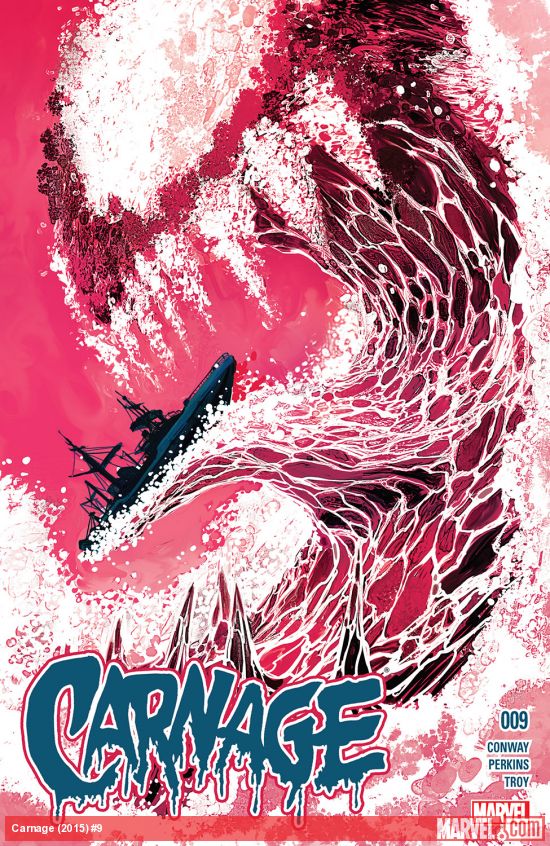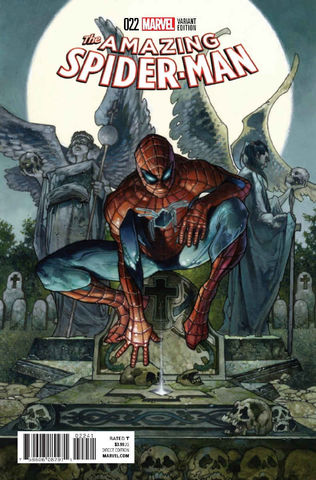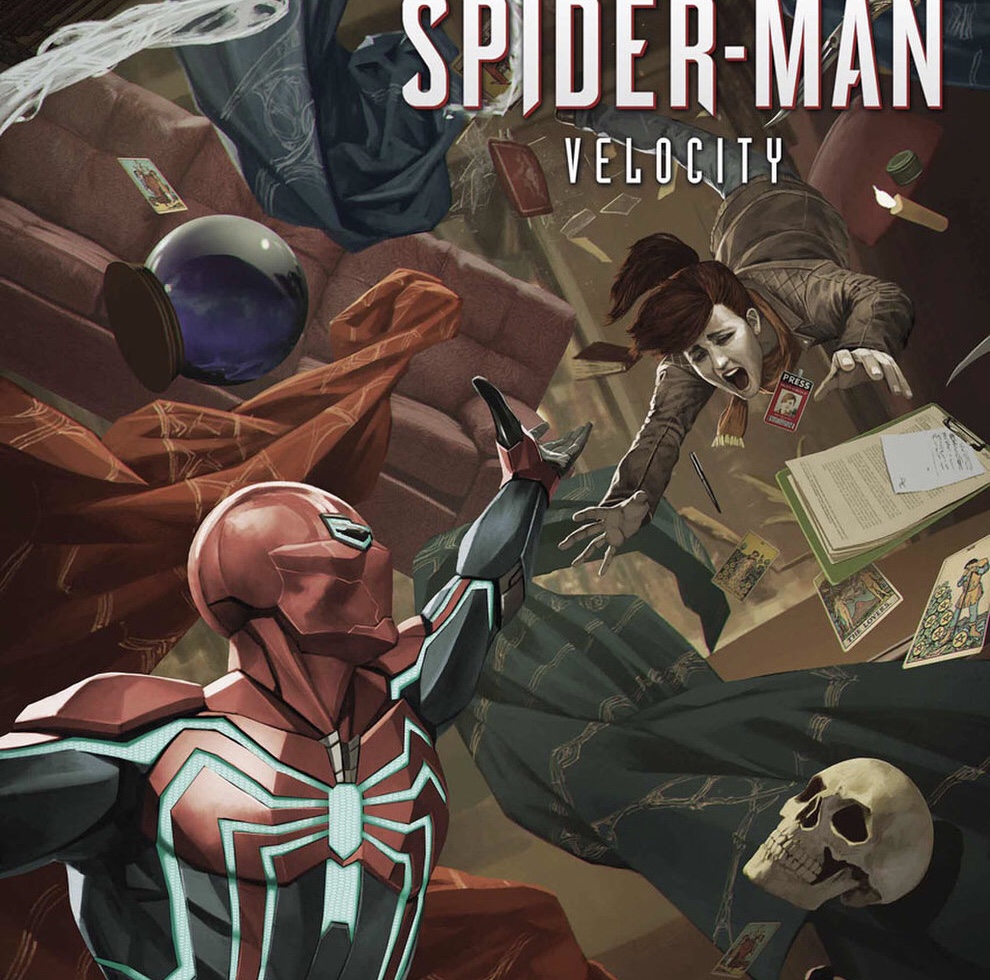“Sea Devil” starts going ahead-full as Carnage enacts a contingency plan to corrupt one of the Children of the Midnight Sun.

WRITER: Gerry Conway
ARTIST: Mike Perkins
COLOR ARTIST: Andy Troy
LETTERER: VC’s Joe Sabino
COVER by Mike Del Mundo
EDITOR: Darren Shan
EXECUTIVE EDITOR: Nick Lowe
CARNAGE CREATED BY David Michelinie and Mark Bagley
STORY (with commentary): Agent Dixon comes out to introduce herself to Jubulile, having been indisposed beneath decks (we’ll see why) since the young girl was brought on board in #6. When they shake hands, however, both of their eyes turn red and an ethereal energy erupts from their point of contact, showing flashes of the story of this book thus far.

 Flashback (*groan*: again, for the third issue in a row) 5 days prior: The cast is racing across the Indian Ocean from Jakarta, trying to catch Carnage and Brother Gregori of the Chthonic Brotherhood, who mutually abducted each other last issue and are now aboard a freighter called the “Caspian Sea.” Dixon, John Jameson, and Manuela Calderon question Voctoria Montesi’s motives, and wonder how the Children of the Midnight Sun are able to have such apparently ample funding to provide a private jet and a speedboat in such short notice, but are interrupted by Eddie Brock when he calls them up to the navigation room. Montesi tells them that Carnage’s ship is close. She says that Kasady is searching for an altar, somewhere in the Ocean, on an uncharted island which is guarded by another cult called the Daughters of Chthon. Apparently Gregori is the only one who knows the actual location of the island, which is why Carnage found him out.
Flashback (*groan*: again, for the third issue in a row) 5 days prior: The cast is racing across the Indian Ocean from Jakarta, trying to catch Carnage and Brother Gregori of the Chthonic Brotherhood, who mutually abducted each other last issue and are now aboard a freighter called the “Caspian Sea.” Dixon, John Jameson, and Manuela Calderon question Voctoria Montesi’s motives, and wonder how the Children of the Midnight Sun are able to have such apparently ample funding to provide a private jet and a speedboat in such short notice, but are interrupted by Eddie Brock when he calls them up to the navigation room. Montesi tells them that Carnage’s ship is close. She says that Kasady is searching for an altar, somewhere in the Ocean, on an uncharted island which is guarded by another cult called the Daughters of Chthon. Apparently Gregori is the only one who knows the actual location of the island, which is why Carnage found him out.
When the group catches up to the Caspian Sea later that night and climb aboard, they cannot find the crew. Before continuing their search beneath the decks, Montesi informs them that she has inscribed Chthonic runes on the body armor of the rest of the supporting cast to protect them from Carnage (huh? – read why this shouldn’t work in the Conway’s Occult Corner of this review). Brock objects to this strategy, saying that only a symbiote can stop another symbiote (I wonder if this is a nod to those early Carnage stories in Amazing when Spider-Man was so overwhelmed by Carnage that he was willing to make a deal with Venom, his then-arch-nemesis, to take him on). Dixon rebukes Brock, however, revealing that she has the symbiote-buffer from the first arc in her possession, and has no intention of using it. When they go below, the group is confronted with a horrifying scene: the crew of the ship lies strewn across its lower levels, not only torn to pieces but half-converted into Carnage-puppets (Perkins nailed this sequence – it actually gave me a little chill when I saw this page). Thinking everyone is dead, they’re startled when one of the deformed crewmen grabs them, tells the group of how Carnage tried (and mysteriously failed) to possess them, and begs for death, which Brock accommodates without a moment’s hesitation. Before they can continue their search, the group is ambushed by Carnage’s tendrils, and falls back deeper into the ship. Dixon, however, is singled out and separated from the rest of them as the tendrils back her into a candle-lit chamber containing a trussed-up Brother Gregori and the Darkhold. Gregori warns Doxin about the danger Carnage represents and she is knocked out by one of the tendrils.
When Dixon regains consciousness, she is hanging upside-down in chains, with Carnage right in her face, telling her that he has a plan for her that is worse than death. To be continued. . .
ANALYSIS: I really enjoyed this. One of my primary complaints about the last issue was that the supporting cast in this book was starting to feel like exposition-tools and little else. Here, however, while they’re still filling in the time gap between #5 and #6, we get an unexpected twist with Agent Dixon and a pretty creepy sequence with the cast as they hunt Cletus aboard the Caspian Sea. It’s nice to have these characters doing more than sitting around and talking (looking at you, Bendis’ Avengers books).
The storytelling has improved too. It finally feels like “Sea Devil” is going somewhere again and not just stumbling to hit plot beats. The choice to tell the story through Dixon’s internal narrative, while not making her all that more compelling of a character, does effectively shift this book from being plot-driven to character-driven, which is always a good thing.
And, as I mentioned above, Mike Perkins does an excellent job in this comic. It is one creepy book to look at. His art is detailed, yet gritty, which has got to be a difficult balance to strike. Granted that his work in this book really always has been pretty good thus far, and I’m embarrassed to say I’m just now realizing this because I’m not distracted by his reinterpretation of Carnage’s visual. Carnage only shows up on the last page, so we’re really able to focus on Perkins’ storytelling and character work. He’s definitely due some long-overdue compliments from this reviewer for his competence in those areas. Especially, as stated above, that sequence beneath the decks: that was horrifying. Conway’s writing really complimented it too, as you could almost feel Dixon’s hesitant fear as she and her allies descended into that hell-scape.
Speaking of the matter, it was a pretty bold move to only include Carnage, this book’s title character, on the last page. Normally this wouldn’t sit well with me, as it would come off as being a kind of unfulfilled promise, but here it really works. That’s because Conway and Perkins make Carnage’s presence felt in this chapter through his absence. Everyone in this book is scared of Kasady in their own way, particularly Agent Dixon here. Again, framing the narrative in first person was a good choice as it allows the reader to get into the story through the mind of someone who’s actually experiencing it, so it’s hard not to share Dixon’s fear. This made Carnage #9 a pretty enjoyably suspenseful read, which a book about Carnage that’s marketed as a horror-comic should be.
 As for my complaint, I was a bit disappointed at the onset to find that this is yet another flashback issue, the third in a row. And while things really picked up steam, and the comic became very enjoyable, when the cast reached the Caspian Sea, we still don’t get any closer to that island altar in this issue. The cast is still, technically, in the same place here that they were in issue #6. While this is forgivable because this issue contains a pretty good story, with a pretty cool twist in Dixon’s corruption, it still grates a little because the greater story of this title’s run is not moving forward very quickly.
As for my complaint, I was a bit disappointed at the onset to find that this is yet another flashback issue, the third in a row. And while things really picked up steam, and the comic became very enjoyable, when the cast reached the Caspian Sea, we still don’t get any closer to that island altar in this issue. The cast is still, technically, in the same place here that they were in issue #6. While this is forgivable because this issue contains a pretty good story, with a pretty cool twist in Dixon’s corruption, it still grates a little because the greater story of this title’s run is not moving forward very quickly.
CONWAY’S OCCULT CORNER: And now, some reflections on the occult. . .
“I thought we could control him. Thought we could bind him. But we can’t. He’s like the storm. Unstoppable.” –Gregori, of the Chthonic Brotherhood
Here I will address my “huh?” aside from the commentary. Let me preface by saying that I know I’ve complained before (in my review of #4) that Carnage’s vulnerability to the knives and weapons of the Chthonic Brotherhood had better be due to the preternatural power of those weapons or their bearers, since simple knives and maces wouldn’t do squat to the character. Now, seeing that this is the case (as revealed last issue), I still find myself catching an inherent contradiction in Victoria Montesi’s logic that ‘the power of Chthon will protect us from the power of Chthon.’ This is not me contradicting myself as in the former cases we were dealing with Carnage’s vulnerability and in the latter case we’re with the supporting cast’s protection from Carnage and the Darkhold. Now, with all due respect to those people who believe that when it comes to the evils of the world, “sometimes you have to fight fire with fire,” this is, in the concrete, absolutely absurd. Have you ever actually tried that? Fighting fire with fire? Does. Not. Work. You fight fire with water. Or dirt. Something that will actually extinguish it. This is especially true when dealing with the occult. Using the runes of Chthon to fight Chthon sounds ridiculous to me. It’s just putting the rest of the supporting cast under the same spiritual authority of the fallen god as Carnage is, granted not to the same degree but still. Wouldn’t it make more sense for Montesi to use the runes of another one of the elder gods who imprisoned Chthon? Just sayin.
This gets at one of the prime mistakes that specifically Venom, but still kind of Spider-Man too, has made when dealing with Carnage before. In Spider-Man’s case, it was getting Venom. Yes, Brock adds a significant amount of power to the equation, but dealing with a symbiote using a symbiote is the fire-with-fire thing all over again. Why not, and here’s the ironic thing, use actual fire instead (which, even before this title started, should be Cletus’ only weakness)? And in Brock’s case, you see the delusion even more: his statement from #3, “I ride Toxin, he doesn’t ride me,” is a lie. Ironically, it’s Carnage who actually gets this, and not only accepts but embraces it. Brock thinks that he can enact dominion over the Toxin symbiote because he’s strong-willed (and probably “holy” in his deluded mind). This has been shown time and again to be a lie with symbiotes, which Spider-Man, being the good person that he is [was], knew intuitively from the get-go: as soon as he figured out that the Venom symbiote was a person with an agenda of its own, he got rid of it. Now, go back and replace “symbiote” with “demon” in this paragraph and Gregori’s statement above will have even more context.
Now that I think about it, symbiotes have often been compared to demons in their appearances through the years, sometimes even directly (I’m failing to recall a specific instance – a Crawlspace No-Prize to anyone who can in the Comments!). Maybe putting Carnage in the current setting makes more sense than it first seemed? If this was a deliberate move on the creative team’s part, then very well done there.
Anyway, to wrap this section up, the idea that evil, either madness or the demonic, can be controlled, much less dominated like Brock thinks, is absurd. Carnage is conquered by Spider-Man’s heroism and goodness (and not in the saccharine way that it was at the climax of “Maximum Carnage,” but by showing that he won’t be pushed into the same darkness that Cletus lives in), not by Venom’s anti-heroism and brutality. Evil is diffused and snuffed out by Goodness, not by more Evil. This book’s problem is that it’s missing a “Spider-Man”; all of the characters here are deluded into thinking that they can overcome evil by dabbling a bit in it themselves, not by abandoning evil altogether, which is an honest, if chilling, portrayal of the true seductive nature of Evil. They’re all willing to cross moral lines. At what point does this result in the victory of the very foes they fight?
Questions to ponder as we wait for next month’s issue. As always, thank you to Gerry Conway, Mike Perkins, and crew for another good read, and to you for checking out this review. See you all in July for the final part of “Sea Devil.”
GRADE:
B-
pretty good (“Sea Devil” Part 4 picks up the pace after two decelerating chapters and delivers a creepy read full of twists and chills, despite being yet another flashback issue)









The biggest instance I can remember about the symbiotes being compared to demons is a statement from Eddie himself in the “The Hunger” story line (the second one) where he says to a priest at confessional that: “I think the Lord decided to punish me for my terrible sin. I think he put a demon inside me.”
Also, from what I understand, Carnage can be hurt and subdued by the runes and those with the power of Chthon (that’s why they were able to attack and bind him in issue #8, and why the Darkhold Dwarf was able to repulse the symbiote.) As far as I understand it, the reason they are able to do that is because Cletus’ blood touched the Darkhold and it gave him the power, but the taint of Chthon as well., so those with Chthonic powers and such can affect him now. But only his blood, as when he retracted the symbiote, he was able to escape the chains. Gregori says to him “The words and symbols that empower you by blood, bind you by blood.”
In Issue #4 when they attacked him, even if the weapons they used had runes on them, they shouldn’t have affected Carnage because he had not yet had his blood spilled on the Darkhold yet. Unless just being in the presence of it, or being the Red slayer already predisposed him to being harmed by them, it seems like the weapons they used to spill his blood in #4 should have been nothing to Carnage as his blood had not yet been tainted and bound by the Darkhold.